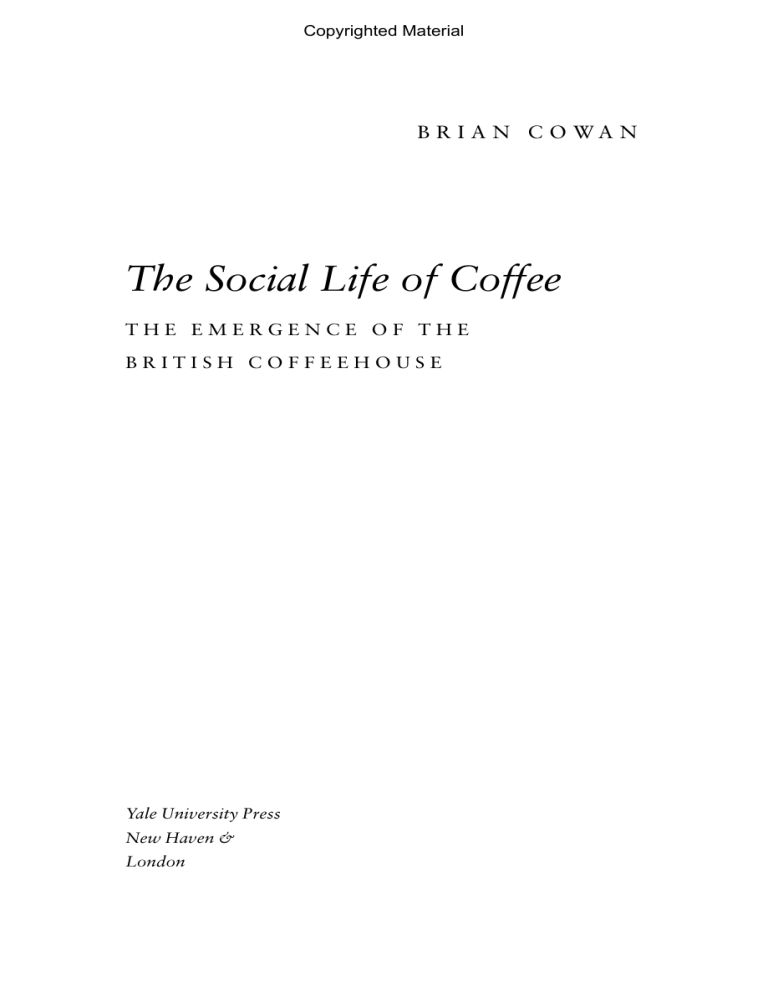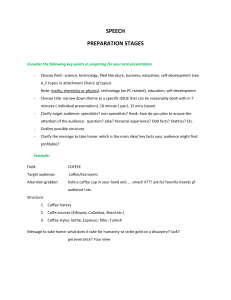
Copyrighted Material B R I A N C O WA N The Social Life of Coffee THE EMERGENCE OF THE BRITISH COFFEEHOUSE Yale University Press New Haven & London Copyrighted Material Published with assistance from the Annie Burr Lewis Fund. Published with the assistance of the Frederick W. Hilles Publication Fund of Yale University. Copyright ∫ 2005 by Yale University. All rights reserved. This book may not be reproduced, in whole or in part, including illustrations, in any form (beyond that copying permitted by Sections 107 and 108 of the U.S. Copyright Law and except by reviewers for the public press), without written permission from the publishers. Set in Sabon type by Keystone Typesetting, Inc. Printed in the United States of America. Library of Congress Cataloging-in-Publication Data Cowan, Brian William, 1969– The social life of coffee : the emergence of the British coffeehouse / Brian Cowan. p. cm. Includes bibliographical references and index. isbn 0-300-10666-1 (cloth : alk. paper) 1. Coffeehouses—History. 2. Coffee—History. I. Title. tx908.c68 2005 647.9509—dc22 2005043555 A catalogue record for this book is available from the British Library. The paper in this book meets the guidelines for permanence and durability of the Committee on Production Guidelines for Book Longevity of the Council on Library Resources. 10 9 8 7 6 5 4 3 2 1 Copyrighted Material Introduction Hard as it is to believe today, there was once a world without coffee. Coffee was entirely unknown before the middle of the fifteenth century, when it began to make its way into the drinking habits of the peoples living in the Red Sea basin. After its discovery, the rise of coffee seems to have been inevitable. It became one of the great success stories of the changing consumer habits that reshaped the early modern world. Although it was controversial in every society into which it was introduced, coffee soon found its place alongside more traditional drinks such as beers, wines, waters, and juices. This book focuses on the development of this new taste for coffee, and the emergence of a new social institution, the coffeehouse, in the British Isles. Coffee drinking spread from the Red Sea region throughout the Ottoman Empire over the course of the sixteenth century.∞ But what induced the British peoples to adopt the custom of a foreign, and even non-Christian, land during the seventeenth century? Why did coffee and related hot drinks, such as tea and chocolate, succeed where so many other exotic drugs and consumables failed? What accounts for the emergence of an entirely new social institution, the coffeehouse, as the primary place in which these new drinks were consumed? The answers to these questions will take us deep into the mental, political, social, and economic structures of everyday life in a world which only gradually came to recognize a life accentuated by coffee and populated by numerous coffeehouses. 1 Copyrighted Material 2 Introduction The history of coffee and coffeehouses offers a new perspective on some of the major themes in recent historical writing on early modern Britain. This is a period which has often been characterized as experiencing a ‘‘consumer revolution’’ as well as the rise of a ‘‘public sphere’’ of critical debate beyond the regulation of the monarchical state.≤ If the late seventeenth and eighteenth centuries saw something like the birth of a consumer society, then the rise of the new coffee-drinking habit is a good indicator of this phenomenon. To learn why and how seventeenth-century English consumers came to desire a strange new drink such as coffee can take us a long way toward understanding the origins of the consumer revolution of the long eighteenth century. Concomitantly, the notion of a public sphere, first articulated by Jürgen Habermas, has always held up the coffeehouse as the prime example of the sort of institution that characterized this new social world. In this account, the coffeehouse has been understood to be a novel and unique social space in which distinctions of rank were temporarily ignored and uninhibited debate on matters of political and philosophical interest flourished. If there was a relation between the birth of a consumer society and the rise of a public sphere, then the best way to understand it is through a thorough study of the origins of coffee drinking and coffeehouse society. The Social Life of Coffee revisits and revises both the consumer revolution and the public sphere paradigms. It looks for the reasons for the spread of new consumer practices such as coffee drinking and it traces the relation between these new tastes and the development of new modes of social organization. In both cases, novelty had to be made legitimate. Neither the commercial success of coffee nor the social success of the coffeehouse was a given. The early modern world without coffee had to be coaxed into accepting the hot black broth and the places in which it was drunk. The rise of the coffee-drinking habit required a great deal of persuasive work on the part of its earliest proponents, and the legitimation of the coffeehouse required that people think differently about the role of public association in the social order. Curiosity, commerce, and civil society provide the three major themes through which this book explores the rise of coffee and coffeehouses. The crucial social legitimacy for both the coffee commodity and the coffeehouse was provided by the unique combination of a genteel virtuoso ‘‘culture of curiosity’’ and a rapidly growing commercial world centered in London.≥ Civil society in early modern Britain developed as a product of this mixture of gentlemanly curiosity and urban commerce. The virtuosi provided the catalyst that spurred the initial commercial interest in coffee and the development of the coffeehouse as a significant social institution, but this initial interest was then seized upon and transformed by the exigencies of urban sociability. Cof- Copyrighted Material Introduction 3 fee culture began with virtuosity and quickly became an integral part of urban living. Just as coffee drinking was transformed by its move from a relatively restricted circle of gentlemanly elites to a much broader and diffuse urban milieu, so were the social lives of the virtuosi and the city dwellers who drank coffee and frequented coffeehouses. Dramatic changes in British consumer preferences and in British public life did accompany the rise of coffee drinking and coffeehouses in the later seventeenth century, but these changes did not happen automatically; they were accompanied by trepidation and often outright resistance. British coffee culture developed slowly, and its ultimate success was achieved less through rapid and radical change than through its gradual insinuation and adaptation into the basic structures of everyday life. The supposed early modern consumer revolution was less revolutionary than it was evolutionary, and the rise of the coffeehouse public sphere was accepted by the British old regime only when it was clear that coffeehouse politics would not upset the status quo. The making of the British coffee world cannot be understood as a telling example of the inexorable process of the making of the modern world. The rise of coffee did not inaugurate the ‘‘creation of the modern world’’; coffee and coffeehouses were received and popularized by an old regime and a pre-industrial society.∂ Coffee and modernity did not emerge in tandem. The story told in this book is therefore a resolutely early modern one: the first coffeehouses in the British Isles were not today’s global Starbucks corporate empire writ small. They were the product of a world in which novelty was not a sales pitch, but something to be looked at askance. Similarly, early modern coffeehouse politics did not prefigure the rise of modern liberal democracy: the first coffeehouses were shaped by the prejudices of a world in which kings and queens were still thought to rule through some sort of divine sanction and the participation of the common people in political action was something to be feared rather than celebrated. Insofar as it emphasizes the traditional as much as it recognizes many of the incipiently modern aspects of the reception of coffee in early modern British society, this book contributes to a ‘‘post-revisionist’’ history of the seventeenth and eighteenth centuries which remains as yet incomplete and often contradictory.∑ Whiggishly optimistic and triumphalist paradigms such as the consumer revolution and the rise of a public sphere do not do justice to the fitful and uncertain acceptance of coffee in early modern Britain and this work joins revisionist critics of these whig views in rejecting their anachronistic and teleological anticipations of the modern present in the early modern past. Nevertheless, the social fact of coffee’s acceptance must be recognized, as most ‘‘revisionist’’ histories of the period have stubbornly refused to do. The Social Copyrighted Material 4 Introduction Life of Coffee offers an account of the rise of coffee and coffeehouses in which their success is not assumed but explained. The chronological scope of this study covers the long Stuart century from the last years of Elizabeth’s reign around 1600 until the opening years of George I’s reign around 1720. It begins in the early seventeenth century with the first few discussions of coffee and coffeehouses in the English language, but for the first half of this period (c. 1600–1660) coffee was primarily noticed and consumed by a select group of English virtuosi. After the Restoration, the efflorescence of coffeehouse culture changed all of this and therefore much of the rest of the work focuses on the latter half of the ‘‘long seventeenth century.’’ The end point of the study around the year 1720 has been chosen because by that time both the coffeehouse and coffee consumption had become firmly entrenched within British society. A social template had been set and it was not to change greatly for the next hundred years. At the same time, the 1720s saw the growing popularity of two important competitors to coffee in the English beverage market: tea and gin. The phenomenal success of tea in insinuating itself into British consumer preferences as the national drink began with the opening of the Canton trade to China on a regular basis by the English East India Company in 1717.∏ At nearly the same time, gin also took hold of the popular palate, and the 1720s are well known as the decade in which gin drinking and its regulation became the objects of intense public scrutiny.π The third decade of the eighteenth century did not see a great qualitative or quantitative transformation in the nature of British coffee culture, but by this time coffee and coffeehouses had been so thoroughly assimilated into the fabric of British society that they had ceased to be controversial. The Anglicization of oriental coffee was complete.




